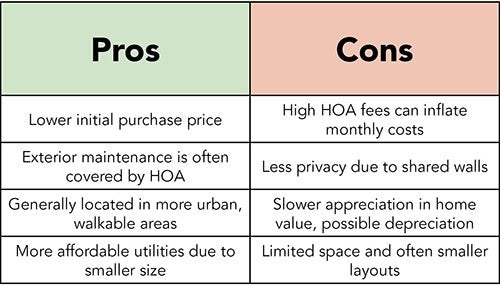
Attached vs. Detached Single Family Homes: Which is Right for You?
- Author:
- Zachary Sodolak
- Posted:
- September, 23, 2024
- Categories:
- About Our Communities
When searching for a new home, one of the biggest decisions you’ll face is whether to choose an attached or detached single-family home. Both have their unique benefits and drawbacks, which can make a significant impact on your lifestyle, budget, and long-term investment. In this article, we’ll break down the key differences between attached and detached homes, covering everything from costs and maintenance to resale value. By the end, you’ll have a clearer understanding of which option might be the best fit for your needs.
What is an Attached Single Family Home?
An attached single-family home is not a standalone structure; it shares walls with at least one other dwelling. Common examples of attached homes include condos, townhomes, and duplexes or quadplexes, where individual units are available for purchase. These homes provide more affordable entry points into homeownership but come with their own set of trade-offs.

Common Characteristics of Attached Homes:
- Monthly Cost: Attached homes are typically more affordable than detached homes upfront. However, they often come with higher HOA (Homeowners Association) fees, which can significantly increase your monthly payments.
- Maintenance: One major perk of attached homes is that the HOA usually covers exterior maintenance, including the roof, foundation, and sometimes even landscaping. However, interior upkeep and repairs remain the homeowner’s responsibility.
- Floor Plans & Size: Floor plans can vary, but attached homes rarely offer more than 2,000 square feet. This smaller size often makes them a better option for smaller households or those looking for a low-maintenance lifestyle.
- Financials: Attached homes typically appreciate more slowly than detached homes. In some cases, they may even lose value depending on the age of the property and location, making them a less reliable long-term investment.
Pros and Cons of Attached
Single-Family Homes:
 |
What is a Detached Single Family Home?
A detached single-family home is a standalone structure with no shared walls, offering more space and privacy. This is the traditional image most buyers have when thinking of a home, and it’s what most builders like Kindred Homes focus on. These homes often serve as better long-term investments due to their stronger appreciation potential.
Common Characteristics of Detached Homes:
- Monthly Cost: Detached homes are generally more expensive than attached homes, but they may offer a better long-term investment. With no HOA fees, your monthly payment may actually be lower for a similarly priced home, depending on property taxes and mortgage rates.
- Maintenance: Homeowners are responsible for all aspects of maintenance, including the roof, foundation, and major systems like HVAC. While this can be a downside for some, it also means full control over home improvements and landscaping.
- Floor Plans & Size: Detached homes offer more flexibility in terms of size and layout. You’re more likely to find homes over 2,000 square feet, with multiple bedrooms, bathrooms, and often larger yards.
- Financials: Historically, detached single-family homes appreciate faster, offering a higher return on investment. Since 1991, average home prices have increased by around 4.3% annually, making these homes a solid financial choice.
Pros and Cons of Detached Single-Family Homes:
 |
Choosing between an attached or detached single-family home depends on your lifestyle, budget, and long-term goals. Attached homes can be more affordable upfront and come with reduced maintenance, making them ideal for those who prefer a low-maintenance, urban lifestyle. On the other hand, detached homes offer more privacy, space, and better appreciation potential, making them a smarter investment for the future. Consider the pros and cons of each option to determine which best aligns with your priorities and financial situation.
